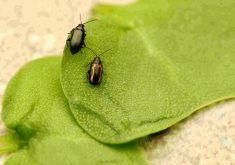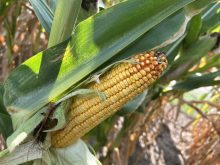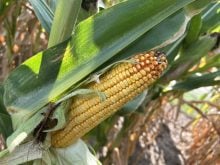It was the year of the armyworm in Manitoba when a high numbers of adults blew in this spring. But farmers have their own army, plus an air force, ready to meet the invaders and possibly keep their numbers below economic thresholds.
“I don’t have enough time to talk about the enormous number of different natural enemies out there, but I’ll mention a couple of good representatives,” said University of Manitoba entomologist Jordan Bannerman.
“Natural enemies provide free pest control and they help outline one of our goals, which is making sure that we maintain and support their populations because we’re better with them than without.”
Read Also

Manitoba boosts stake in cereals centre to $23.5 million
Premier Wab Kinew said the additional project funds will help ‘Trump-proof’ the provincial economy.
Why it matters: Parasitoids and predators like ground beetles can take a big chunk out of pest populations.
There’s nothing new about taking advantage of the pests’ natural enemies. Farmers through the ages have recognized pests and welcomed their predators.
According to Chinese lore recorded in “Nanfang Caomu Zhuang” (“Plants of the Southern Regions”) by Western Jin-dynasty botanist Ji Han, “Jiaozhi people sell ants and their nests attached to twigs looking like thin cotton envelopes, the reddish-yellow ant being larger than normal. Without such ants, southern citrus fruits would be severely insect damaged.”
Today, and closer to home, there are breeding programs for certain wasps used to control certain crop pests.
Parasitoid beneficial insects are some of the most effective, Bannerman said.
“Some of our parasitoids are very specific in what they seek out and what they attack – very specialist natural enemies.”
In the battle with armyworms, for example, there is a tiny wasp.

“The problem that we face with parasitoids is that identification of parasitoids is terribly difficult,” Bannerman said. “Most parasitoids are tiny little black specks, and one of those is [a] very, very small parasitoid wasp called Cotesia.”
The wasps are much too small to attack, subdue and eat a caterpillar on their own. Instead, it jabs the caterpillar with its ovipositor, a tube-like organ that punctures the skin and lays eggs inside.
“They’ll seek out an armyworm caterpillar, lay 10, 20, 30 eggs into it, and those eggs will hatch,” Bannerman said. “The wasp larvae will feed on the inside of the caterpillar for a week or two and then, when those wasps are ready to emerge, they’ll modify the behaviour of the armyworm and make it crawl to the top of a plant.”
Once the caterpillar reaches the top, the wasps cut their way out and start spinning cocoons. They pupate and emerge as adult wasps.
Farmers on the lookout for Cotesia wasps may find what looks like a silky mass on the top of their cereals or forage grasses. These are the cocoons of many wasps emerging from a single caterpillar.
The danger is that farmers may mistake those clusters for insect eggs, said Bannerman.
Because of the diminutive size of many parasitoids, farmers are more likely to see secondary signs, like those silky masses, rather than the wasps themselves.
Hungry beetles
Caterpillars who survive the aerial onslaught may hide on the ground. That’s where the ground troops come in.
Under the crop canopy, pest larvae may find a healthy force of ground beetles ready for a meal.
“This is a group of beetles that really don’t get the attention they deserve,” Bannerman said. “Their larvae are in the ground, in the stubble, in the leaf litter. The adult beetles are essentially soil surface predators.”
Ground beetles are carabids, members of family Caribidae. They have a distinctive head (thin toward the mouth, widening considerably behind the eyes). There are almost 400 species of ground beetles in the Canadian Prairies, some quite large and others less than five millimetres long.

Past that, however, not much is known. They’re difficult to study in the field. Living in the thick vegetation under the crop canopy, they’re difficult to watch. Many are active at night, making it a challenge to learn their habits.
“We have day-active species, while some of our species are primarily active at night,” Bannerman said. “They are going to be down in the stubble and in the cracks during the day and their peak activity will either be early or late in the day or actually overnight.”
The beetles were the focus of sampling work at three locations – Carman, Glenlea and the RM of Brokenhead – last summer by one of Bannerman’s students. At each site, the student dug pitfall traps, each fitted with a cup filled with a preservative. The preservative killed beetles that fell into the traps and kept them from being eaten by any other bugs.
“She had pitfall traps out in her three fields in June, July and August last year,” Bannerman said.
By the end of those three months, the student had collected a little over 10,000 ground beetles.
The beetles love caterpillars, but they’re not specialists like the parasitoids. They’re generalists, eating anything they can catch wherever and whenever they can catch it.
“They will also feed opportunistically on fly maggots, and they will feed on any other insects that get blown out of the canopy,” Bannerman said. “And, if the soil dries down a little bit later in the season and exposes any grasshopper eggs, they’ll snap those up and eat those eggs as well.”
One research project out of the University of Alberta is looking at a particular species of ground beetle, Pterostichus melanarius, as a possible control for pea leaf weevil.
“Most ground beetles are generalist predators that are known to eat slugs and other insects,” Agriculture and Agri-Food Canada entomologist Meghan Vankosky told the Co-operator in June.
“They’ll go after the eggs, the larvae, the pupae, the adults, and then there are groups within the ground beetles that are known to eat weed seeds, so there’s a lot of interest in ground beetles for biological control of pests.”
Where they fit
Predatory insects like parasitoids and ground beetles may help keep pests below economic thresholds and reduce the need for spraying.
Manitoba Agriculture often urges producers to consider beneficial insects when scouting and making spray decisions.
“There’s a lot of natural enemies that are here, that are doing good work, but we don’t necessarily see them, we don’t necessarily notice them,” Bannerman said. “But they’re important to be thinking about as we’re navigating difficult decisions around pest management.”















